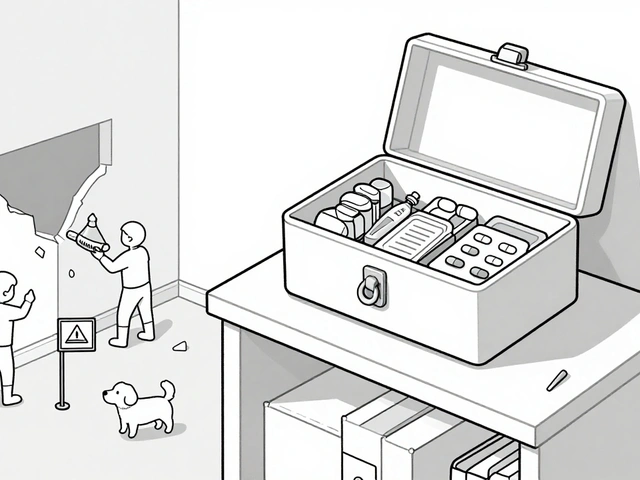
CLL/NHL Treatment Option Selector
Select the patient's characteristics to determine the most suitable treatment option:
Quick Takeaways
- Leukeran ( chlorambucil ) is an oral alkylating agent primarily used for CLL and low‑grade NHL.
- Newer drugs such as ibrutinib and venetoclax often deliver higher response rates but come with different toxicity profiles.
- Choice depends on disease stage, patient age, comorbidities, and convenience of administration.
- Side‑effect monitoring for chlorambucil focuses on myelosuppression and secondary malignancies.
- Cost and accessibility still make chlorambucil a viable first‑line option in many health systems.
What Is Leukeran (Chlorambucil)?
Leukeran is a synthetic alkylating agent that has been used since the 1950s to treat chronic lymphocytic leukemia (CLL) and indolent non‑Hodgkin lymphoma (NHL). It works by adding an alkyl group to DNA, causing cross‑linking that interferes with replication. The drug is supplied as 2mg and 4mg tablets, taken orally once daily for 14‑days in a 28‑day cycle, although dosing schedules vary by physician.
Chlorambucil is listed on the WHO Essential Medicines List, reflecting its long‑standing role in low‑resource settings. FDA approval dates back to 1958, and many guidelines still cite it as an option for patients who cannot tolerate more aggressive regimens.
How Chlorambucil Works: Mechanism and Pharmacokinetics
The molecule belongs to the class of nitrogen mustard alkylators. Once inside the cell, it forms an ethyleneimine intermediate that binds to the N7 position of guanine bases, creating intra‑strand cross‑links. These lesions trigger apoptosis in rapidly dividing B‑cells.
Pharmacokinetic data show an oral bioavailability of ~40% and a terminal half‑life of 2‑3hours, with metabolites excreted renally. Because it is not heavily protein‑bound, dose adjustments are generally unnecessary in mild renal impairment, but caution is advised in severe cases.
Key Side Effects and Monitoring Requirements
Myelosuppression is the dose‑limiting toxicity. Typical laboratory trends include:
- Neutropenia (grade3-4 in 10‑15% of patients)
- Thrombocytopenia (5‑10%)
- Hemoglobin drop (rarely severe)
Long‑term risks involve secondary malignancies such as therapy‑related myelodysplastic syndrome (t‑MDS) and acute myeloid leukemia (t‑AML), especially after cumulative doses >1g.
Standard monitoring includes CBC before each cycle, renal function checks every 2months, and regular skin examinations for early signs of ulceration.
Main Alternatives to Chlorambucil
Over the past decade, several agents have emerged that either belong to the same alkylating family or target distinct pathways. Below are the most commonly referenced alternatives.
Cyclophosphamide is a pro‑drug alkylating agent activated in the liver to phosphoramide mustard.
Often combined with rituximab (the “R‑CHOP” regimen) for aggressive NHL, cyclophosphamide delivers higher response rates in CLL when given intravenously. It carries risks of hemorrhagic cystitis and infertility, necessitating mesna prophylaxis and sperm banking for younger men.
Bendamustine is a hybrid alkylating and antimetabolite that creates DNA cross‑links while also inhibiting checkpoint kinases.
Bendamustine is approved for both CLL and indolent NHL. It is given intravenously at 100mg/m² on days1 and2 of a 28‑day cycle. Clinical trials show overall response rates (ORR) of 70‑80% in CLL, superior to chlorambucil but with more pronounced neutropenia.
Ibrutinib is a Bruton’s tyrosine kinase (BTK) inhibitor that blocks B‑cell receptor signaling.
Oral daily dosing (420mg) makes ibrutinib attractive for older patients. PhaseIII trials (RESONATE, RESONATE‑2) demonstrated progression‑free survival (PFS) >5years compared with chlorambucil. Adverse events include atrial fibrillation, hypertension, and bleeding risk.
Venetoclax is a BCL‑2 inhibitor that restores apoptosis in CLL cells.
Administered orally with a weekly ramp‑up to 400mg, venetoclax achieves deep minimal residual disease (MRD) negativity in up to 60% of fit CLL patients. Tumor lysis syndrome (TLS) is a serious early‑treatment concern requiring hospitalization for high‑risk patients.

Side‑by‑Side Comparison
| Agent | Indication | Route | Mechanism | Typical Dose | Common Toxicities |
|---|---|---|---|---|---|
| Leukeran (Chlorambucil) | CLL, low‑grade NHL | Oral | Alkylating DNA | 0.5‑1mg/kg PO daily ×14 days q28d | Myelosuppression, secondary AML/MDS |
| Cyclophosphamide | CLL, aggressive NHL | IV | Pro‑drug alkylator | 500‑1000mg/m² IV q21‑28d | Hemorrhagic cystitis, infertility |
| Bendamustine | CLL, indolent NHL | IV | Alkylator + checkpoint inhibition | 100mg/m² IV days1‑2 q28d | Neutropenia, rash, nausea |
| Ibrutinib | CLL, mantle‑cell lymphoma | Oral | BTK inhibition | 420mg PO daily | Atrial fibrillation, bleeding, hypertension |
| Venetoclax | CLL (with/without anti‑CD20) | Oral | BCL‑2 inhibition | Ramp to 400mg PO daily | Tumor lysis syndrome, neutropenia |
Factors Guiding the Choice of Therapy
When deciding whether to start chlorambucil or move to a newer agent, clinicians weigh several variables:
- Disease biology: TP53‑deleted or del(17p) CLL responds poorly to alkylators and benefits from BTK or BCL‑2 inhibitors.
- Patient age & comorbidities: Older patients with cardiovascular disease may avoid ibrutinib’s atrial fibrillation risk.
- Renal and hepatic function: Oral chlorambucil is safe in mild renal impairment; bendamustine requires dose reduction if creatinine clearance <30mL/min.
- Administration convenience: Oral regimens (chlorambucil, ibrutinib, venetoclax) reduce hospital visits, crucial in rural NZ settings.
- Cost and reimbursement: Chlorambucil remains inexpensive and widely covered by public health plans, while targeted agents may need special funding.
Practical Tips for Clinicians and Patients
- Start with a baseline CBC, CMP, and viral hepatitis screen before any therapy.
- If opting for chlorambucil, schedule CBC on day14 of each cycle to catch early neutropenia.
- For ibrutinib, obtain baseline ECG and monitor blood pressure monthly.
- When using venetoclax, follow the manufacturer’s TLS prophylaxis protocol: hydration, uric‑acid lowering agents, and inpatient observation for high‑risk disease.
- Educate patients on infection‑prevention measures-hand hygiene, avoiding crowds during neutropenic phases.
Related Concepts and Broader Context
Understanding chlorambucil’s place in therapy benefits from a look at the wider drug families:
- Alkylating agents: Include cyclophosphamide, melphalan, and chlorambucil; all share DNA‑cross‑linking but differ in potency and route.
- Oral chemotherapy: Improves quality of life but demands strict adherence; digital pill‑tracking apps have shown >90% compliance in CLL cohorts.
- Targeted therapies: BTK and BCL‑2 inhibitors aim at pathways that traditional alkylators bypass, offering deeper remissions but also novel toxicities.
- Combination strategies: Current trials explore venetoclax + obinutuzumab or ibrutinib + venetoclax to achieve MRD‑negative status without chemotherapy.
Future Directions
Research is moving toward fixed‑duration regimens that replace long‑term oral agents. Early‑phase studies of a 12‑month ibrutinib + venetoclax course suggest comparable PFS to continuous therapy, potentially reshaping the role of chlorambucil to a “bridge” option only.
Frequently Asked Questions
Is chlorambucil still a first‑line option for CLL?
Yes, especially for older patients with comorbidities or when cost constraints limit access to newer agents. Guidelines recommend it for low‑risk disease and when a rapid, tolerable response is sufficient.
How does the efficacy of chlorambucil compare to bendamustine?
Bendamustine generally yields higher overall response rates (70‑80% vs 30‑40% for chlorambucil) and longer progression‑free survival. However, it requires IV infusion and carries a higher risk of neutropenia, making chlorambucil a safer oral alternative for frail patients.
Can I switch from chlorambucil to a BTK inhibitor later?
Switching is common when disease progresses or if the patient develops intolerable side effects. No washout period is needed, but baseline labs and cardiac evaluation should be repeated before starting ibrutinib.
What monitoring is required for venetoclax to prevent TLS?
Patients with high tumor burden need inpatient monitoring for the first 48hours of the ramp‑up. Frequent electrolytes, uric acid, and creatinine checks (every 4‑6hours) are essential, along with aggressive IV hydration.
Are there drug‑interaction concerns with chlorambucil?
Chlorambucil is metabolized by CYP2C9, so concomitant strong inhibitors (e.g., fluconazole) can raise plasma levels and increase toxicity. Routine medication review is advised.




10 Comments
It’s hard not to wonder why the big pharma lobby keeps touting cheap oral agents like chlorambucil while downplaying the decades‑long data on secondary malignancies and marrow failure.
Patients with cardiovascular comorbidities are painted as “frail” so that newer, pricey BTK inhibitors can be justified, even when the risk‑benefit ratio is narrow.
In reality, the hidden cost of long‑term myelosuppression isn’t just a lab value; it translates into infections, hospital stays, and reduced quality of life.
Thus, any discussion that glosses over these trade‑offs feels like a selective narrative crafted for profit.
The therapeutic algorithm presented here, while ostensibly comprehensive, betrays a reductionist view that reduces complex cytogenetic landscapes to age brackets and comorbidity checklists.
One must consider the molecular underpinnings-del(17p), TP53 mutations, and IGHV status-before relegating a patient to an archaic alkylator.
Moreover, the pharmacoeconomic discourse required to juxtapose the marginal gains of BTK inhibition against the intrinsic value of patient autonomy remains conspicuously absent.
In sum, a truly sophisticated analysis would integrate genomic stratification with real‑world adherence data.
Man, seeing the jump from an old‑school pill like chlorambucil to a sleek daily ibrutinib feels like stepping into the future 😱✨
It’s wild how an oral tablet can shave years off the progression curve while letting patients keep living their lives without the dreaded hospital trips.
But don’t forget, even the newest drugs have quirks-watch that heart rhythm and keep those labs tight! 😬
Honestly, chlorambucil is a relic that belongs in the museum of oncology 😡💊
Its response rates are pale compared to BTK or BCL‑2 inhibitors, and the side‑effect profile is a nightmare for anyone even mildly immunocompromised.
If you’re still prescribing it as a first‑line, you’re doing a disservice to patients who deserve state‑of‑the‑art care.
Time to retire the dinosaur and upgrade the standard of care.
Chlorambucil? 🥱
It’s encouraging to see a balanced overview that acknowledges both the accessibility of chlorambucil and the impressive efficacy of newer agents.
For many patients, especially those with limited resources, an oral option that’s tolerable can make a huge difference in daily life.
At the same time, highlighting the importance of genetic markers helps clinicians tailor therapy more precisely, which is a win‑win for everyone.
The inclusion of pharmacokinetic details such as oral bioavailability and renal excretion underscores how dosing nuances can influence treatment selection, especially in patients with compromised kidney function.
In the contemporary management of chronic lymphocytic leukemia, the selection of an appropriate therapeutic regimen necessitates a multidimensional appraisal of disease biology, patient demographics, and healthcare economics. The historical role of chlorambucil, first approved in the late 1950s, cannot be dismissed solely on the grounds of antiquity, as its inclusion on the WHO Essential Medicines List attests to its enduring relevance in low‑resource settings. Nevertheless, the advent of targeted agents such as Bruton’s tyrosine kinase inhibitors and B‑cell lymphoma 2 antagonists has precipitated a paradigm shift, rendering alkylating agents comparatively less potent in terms of progression‑free survival. Empirical data from phase III trials consistently demonstrate that ibrutinib and venetoclax achieve superior overall response rates, often exceeding 80 percent, versus the modest 30‑40 percent observed with chlorambucil monotherapy. Moreover, the toxicity spectrum of modern agents, while distinct, is generally manageable with appropriate supportive care measures and dose adjustments. It is also imperative to recognize that chlorambucil’s myelosuppressive potential, although less pronounced than that of intensive chemotherapy, still mandates vigilant hematologic monitoring. Secondary malignancies, particularly therapy‑related myelodysplastic syndromes, remain a lingering concern with cumulative exposure exceeding one gram. From a pharmacoeconomic perspective, the low acquisition cost of oral chlorambucil may offset the higher expense associated with continuous BTK inhibition, especially in health systems lacking comprehensive insurance coverage. Yet, the indirect costs associated with frequent clinic visits for laboratory assessments and management of adverse events must also be factored into the overall cost‑benefit analysis. In patients harboring high‑risk cytogenetic abnormalities such as del(17p) or TP53 mutations, the efficacy of chlorambucil diminishes markedly, compelling clinicians to favor targeted therapies. Additionally, adherence considerations favor oral agents; however, the simplicity of a once‑daily regimen does not guarantee compliance, particularly in geriatric cohorts with polypharmacy. The decision matrix therefore becomes a balance between clinical efficacy, safety, quality of life, and economic constraints. It is also noteworthy that emerging fixed‑duration combination regimens, for example venetoclax with anti‑CD20 antibodies, are challenging the traditional continuous therapy model. As the therapeutic armamentarium expands, multidisciplinary collaboration and patient‑centred discussions are paramount to align treatment objectives with individual preferences. Ultimately, while chlorambucil retains a niche role as a bridge therapy or in resource‑limited environments, its position as a frontline monotherapy is increasingly circumscribed by the superior outcomes afforded by newer modalities.
Wow!!! The depth of that analysis is nothing short of spectacular!!! It really paints a vivid picture of how far we’ve come!!! From humble tablets to high‑tech targeted therapies, the journey is electrifying!!! Let’s celebrate both the past and the future of CLL treatment!!! 🚀🚀🚀
Thanks for sharing this, it helps a lot to see the options laid out so clearly.